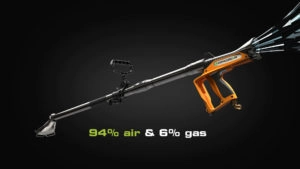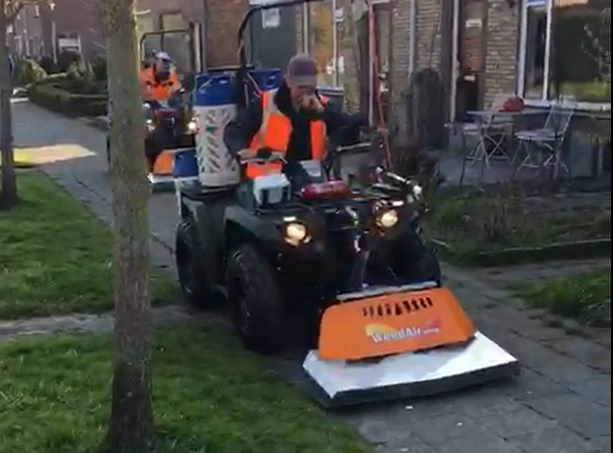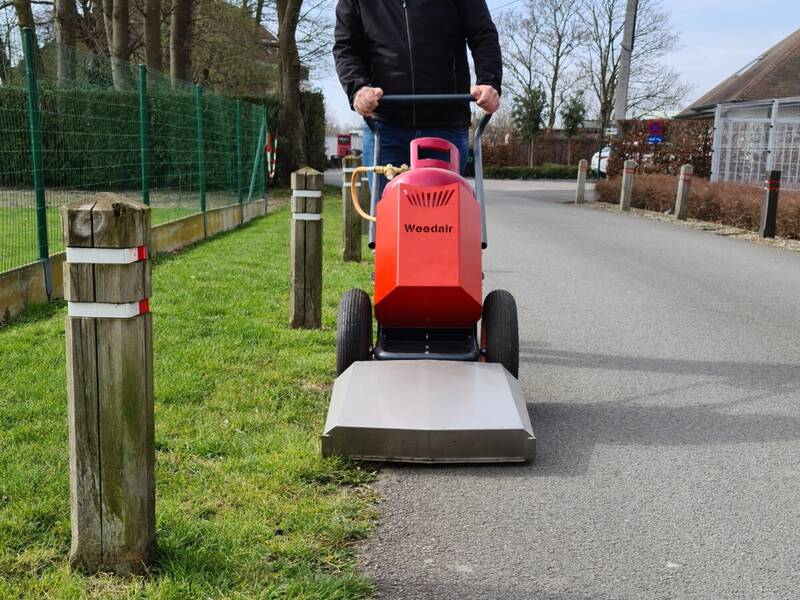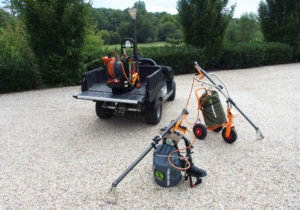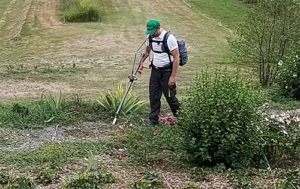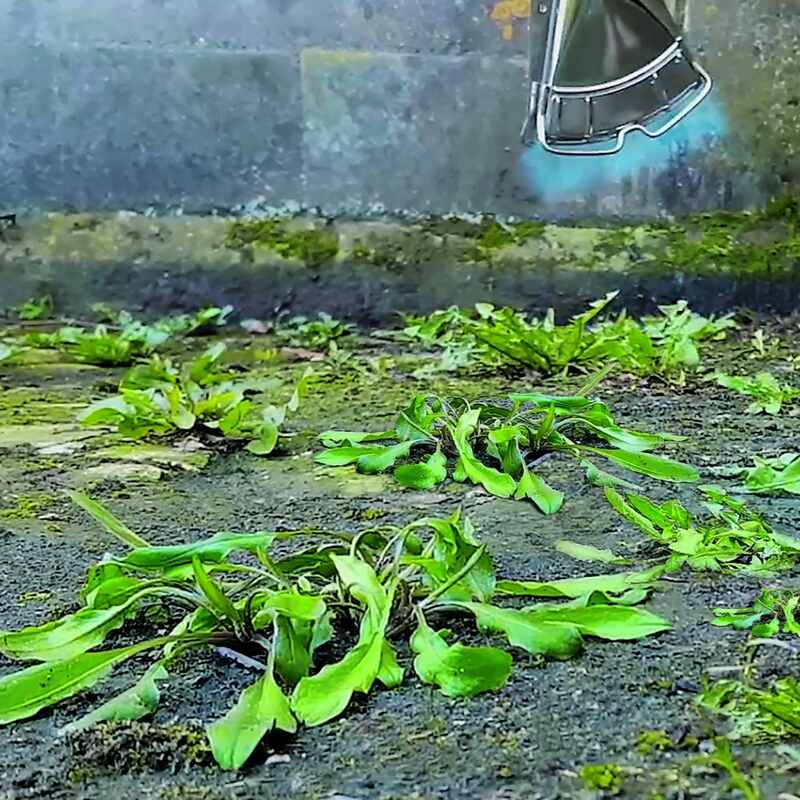Thermal Weed Management

Thermal Weed Management
Thermal Weed Management
Discover effective weed management products and techniques using hot water and hot air
The use of heat to control unwanted plant growth has been around for many years and was certainly in use before the widespread use of inorganic chemicals. A common misconception is that the plant has to be visibly scorched before it will suffer. The fact is, a plant leaf only has to be briefly exposed to a temperature of around 80°C to suffer terminal damage.
This exposure to severe heat bursts the cells in the plant leaf. This in turn renders the plant incapable of converting light energy in to chemical energy (Photosynthesis) effectively causing starvation.
Further thought and research on this subject will reveal this method is most effective on young, fleshy, hungry plants rather than old established woody plants, which may have sufficient amounts of stored energy in their stems and roots to overcome temporary food shortages.
Thermal Weed Management
Thermal weed management utilizes heat to effectively eliminate weeds, providing a chemical-free solution suitable for various environments. This method is especially beneficial for managing invasive weed species that threaten local ecosystems.
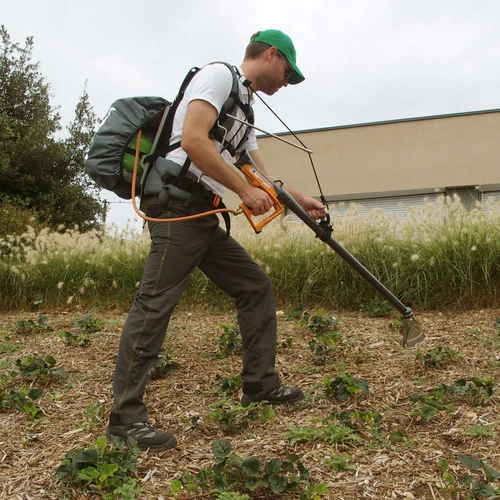
Hot Air Weeders
Hot air weeders employ a concentrated stream of hot air to eliminate weeds without harming surrounding plants. They are particularly effective on young, fleshy plants, which lack the energy reserves of older, established species. By raising the temperature of the weeds, hot air disrupts their cellular structure, leading to rapid and effective removal. Ideal for flower beds, gardens, and pathways, these tools allow for precise targeting.
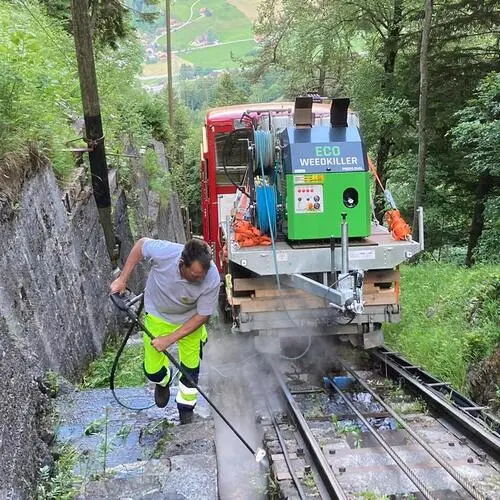
Hot Water Weeders
Hot water weeders deliver boiling water directly to the base of weeds, effectively killing both the plants and their root systems. This method not only targets young, fleshy weeds but also sanitizes the soil, reducing the chance of future growth. By rapidly heating the plant tissues and penetrating the soil, hot water weeders ensure thorough treatment, promoting healthier garden ecosystems.
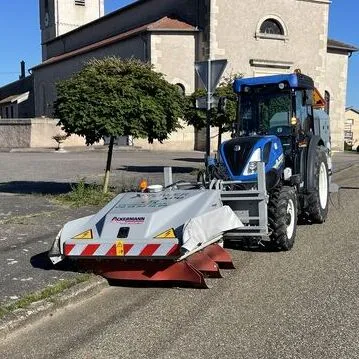
Electric Weeders
Electric weeders are designed for the efficient removal of invasive weeds by applying heat directly to the plants. They excel in managing large infestations and can target deep-rooted species with precision. With adjustable heat output, these tools can be used safely around desirable plants, making them ideal for urban landscapes, parks, and agricultural settings. Electric weeders not only eliminate weeds but also help restore balance to local flora, contributing to healthier environments.
Articles on Thermal Weed Management
No, the plant leaf only requires a temperature of less than 80 degrees Celcius to burst the cells in the leaf which leads to the demise of the plant.
No, the Ripagreen thermal lance must be squeezed to operate it. The gas and ignition stops immediately when the lance handle is released.
The Ripagreen Thermal weed control lance remains cool during use. This is because large volumes of air are being forced through the handle, tube and nozzle before being ignited only at the very end of the lance. The head can even be adjusted immediately after use, as long as the head has been kept the correct distance from the ground. If it has been held too close to the ground, the head can potentially get hot from reflected heat.
Rough gas usage on young annual weeds is 1x 5kg bottle per 1000m² (weeds up to 100mm high)
Rough gas usage on established annual weeds is 1x 5kg bottle per 500m² (weeds up to 200mm high)
Rough gas usage on established perennial weeds is 1 x 5kg bottle per 250m² (Weeds up to 200mm high)
It is difficult to establish the gas usage for weeds outside this specification.
Consider using mechanical methods instead.
Consioder removing the cause of the plants access to soil on hard surfaces.
Use biological controls on organic surfaces such as mulching, dense planting of a desirable species, change treatment timings to fall within the above specification.
Cost of 5kg refill GASLITE cylinder from FLOGAS is about £35.00
In comparison The Easy+ kit uses a 10 - 12kg cylinder on the trolley and the lance as above. A refill for this is considerably cheaper at about £42 which roughly halves to cost of the gas.
Notes. Prior to heat weed control solutions it is recommended all sites are cleared of detritus.
The obvious risk to damage to property is fire. As the required heat to kill a plant is only around 75-85 degrees there is no requirement to concentrate heat on any surface long enough to cause ignition. It is good weed prevention practice to remove all detritus from hard surfaces. This is especially important to reduce any risk of fire. A risk assessment should be conducted on all areas and all risks minimised or mitigated. These product have been used, without incident on many types of ancient and modern surfaces.
The Health and Safety Executive (HSE) provide information on their website regarding various aspects of storage, transporting, use and disposal of LPG cylinders. The suppliers of the gas such as Calor and Flogas also provide information. Training should be provded to the opperator on installation of the equipment by either Kersten (UK) Ltd or your supplying dealer. HSE state the following : LPG cylinders Cylinders should be stored preferably in the open air on a concrete or load-bearing surface. Flammable liquids, combustible, corrosive, oxidising materials, toxic materials or compressed gas cylinders should be kept separate from LPG containers in general. Containers should be stored with their valves uppermost. The maximum size of any stack should not exceed 30,000 kg. For storage indoors, no more than 5000 kg may be stored in each purpose designed building compartment and a maximum of five compartments may exist in a single building.
Liqid Gas UK website provides a useful PDF information sheet regarding the use of LPG in cylinders.
Manufacturers specification states the the Ripagreen machine operates at levels of less than 85db. This is an industry standard figure above which ear protection is required. In our experiance however, the Ripagreen lance operates at a level around 60-70db or equivilent to a conversation. Our tests have shown that the operation of the machine in public areas does not appear to cause any concern or behavioral change in peoples attitude.
No, you do not need a licence to use a Ripagreen Thermal Lance to kill weeds.
The gas bottles for the Ripagreen system are commonly available from local gas stokists of Calor or flogas. The gas used is Propane gas commonly used for BBQ's and other heating. We like these new Gaslight cylider from Flogas becase they are much lighter to carry than their steel equivilent.
The Ripagreen uses hot air to kill plants. This method is suitable to use in a much wider variety of weather than many other systems.
The hot air is not affected by drift in the same way chemicals are, so the Ripagreen can be used in moderately windy conditions, provided the flame can be safely controlled.
The Ripagreen is just as effective at killing the plant in the rain, as moisture is a good conductor of heat. The ripagreen operates at temperatures of between 400 - 600 degrees celsius, so it is not largely affected by cold or wet weather.
This makes is a reliable tool for year - round use.
Care should be taken on very hot and dry days, as the heat can cause very dry maerial to catch fire. It is good practice to carry a fire extinguisher when using the Ripagreen and other flame or heat based weed control products.
There are two typical sizes of gas bottle for the Ripagreen. The easy kit uses a 13kg bottle and the mobility kit uses a 5.5kg bottle of gas. You can get these bottles from your local calor or flogas stockists.
The ripagreen uses a regulator to adjust gas consumption. On a low setting the gas is used at approximately 2.9 KG per hour. So this will last about 2 hours of trigger time in the smaller bottle and 4 - 5 hours using the larger bottle.
The machine only uses gas when the trigger is pulled, which means that gas is not consumed when it is not pointed at a weed. In typical conditions this means that a bottle will realistically last much longer than the times stated above.
The Ripagreen uses hot air to kill weeds. When a plant is exposed to temperatures of more than about 76 degrees, the chloroplasts (the cells in the leaf that carry out photosynthesis) will burst or congeal. By destroying these cells, the plant is unable to convert light into energy. It therefore starves the plant, which dies within 72 hours. You will usually start to see the effects of the heat treatment within a few minutes.
Hot air is a very effective tool for treating many weeds in a golf course scenario. A big problem we are often asked to eliminate is the use of chemicals in bunkers, due to the walking of chemicals over the nearby grass and other situations where drift is an issue.
With thermal methods, you can be much more targeted and leave no residues, therefore they are very suitable for applications on a golf course. Many courses have purchased our Ripagreen kits to solve this specific problem.
Hot water will penetrate the soil, which acts as a great insulator - keeping the water good and hot. This allows the water to heat the roots of the plants effectively cooking them. Hot air will not penetrate the soil, so has less effect on root systems.
However, this does not mean that hot air is ineffective. It works very well on annuals and mosses. We encourage people to remove the soil on hard surfaces, which will typically change the types of weeds which emerge. This will mean you are dealing with fewer perennials and woody plants and more often encountering just annuals and mosses, which hot air is very effective at killing.
You can also aid the efficacy of thermal treatments by carrying them out as early in the plant life cycle as possible. They can also be used as a preventative tool, by sterilising the seeds near the surface of the soil.
In noise-sensitive areas, thermal weed machines, especially hot water machines such as Eco Weedkiller which are nearly silent in operation. Using those devices could minimise disturbance while maintaining a weed-free environment in those areas. The Eco Weedkiller SP Series uses electricity to heat the water, which means there is no engine running when the machine is in use.
We also offer battery powered two wheel tractors, which greatly reduce the noise associated with weed brushing and sweeping. Electrifying your fleet can come with many other benefits too, such as reduced hand arm vibrations and cheaper running costs.
The Eco Weedkiller Products use hot water to kill weeds. When a plant is exposed to temperatures of more than about 76 degrees, the chloroplasts (the cells in the leaf that carry out photosynthesis) will burst or congeal. By destroying these cells, the plant is unable to convert light into energy. It therefore starves the plant, which dies within 72 hours. You will usually start to see the effects of the heat treatment within a few minutes.
Eco Weedkiller offers new technology for weed control based on hot water. The water is heated via electricity and then kept warm in an insulated tank. The device will keep its warmth (more than 100 degrees Celsius) for at least eight hours after disconnecting the power. The device does not need to be connected to the electricity network or water supply during use. You can go wherever you wish.
The short answer is yes. But this is subjective. The Eco Weedkiller system is extremely efficient compared to other heat systems on the market which use a diesel generator to keep the water at the correct temperature.
The machine uses electricity to heat the water to the desired temperature and then keeps it hot using a specially insulated tank and keeping the water under pressure. This means there is no need to burn fuel all day to keep the water hot.
The electricity used to do the heating could be supplied from any source, including solar energy for example; which makes it possible for the product to be extremely environmentally friendly.
The output of the Eco Weedkiller is simply boiling water, which is very clean and safe fro the environment, and makes it safe to use in many areas where herbicides such as glyphosate are unsuitable or simply undesirable.
Further to this you can make this solution more environmentally friendly by following a Weed Prevention Strategy.
Eco Weedkiller uses hot water to kill plants. This method is suitable to use in a much wider variety of weather than many other systems.
The hot water is not affected by drift in the same way chemicals are, so the Eco Weedkiller can be used in moderately windy conditions, provided the water can be safely controlled.
The hot water is still effective at killing the plant in the rain however, it does rely on the hot water, so more water might be required in very cold weather.
This makes it a reliable tool for year - round use. Hot water can be used safely in most weathers.
The product uses water, which is delivered at over 100 degrees. Therefore, there is a risk of some types of material such as thin plastics etc deforming and a risk of scalding if the water comes into contact with someone's skin. A risk assessment should be conducted on all areas and all risks minimised or mitigated. These product have been used, without incident on many types of ancient and modern surfaces.
No, you do not need a licence to use hot water to kill weeds.
The Eco Weedkiller products are virtually silent in operation. There is no engine, so all you hear is the water funning onto the surface and a small hiss, indicating it is at the correct temperature (over 100 degrees Celsius).
There are versions with a 300 litre and 600 litre storage tanks as well as a small Garden version with a 25 litre water tank. Using water allows great penetration into the soil, allowing successful treatment of perennial plants with more established root systems in many situations. The rule of thumb is that 2–2.5 litres of hot water is needed per square metre in areas with 100% greenery coverage. This means that 300 litres of water is enough for 100–150 green square metres.
Notes. Prior to heat weed control solutions it is recommended all sites are cleared of detritus.
The trigger must be pulled in order to deliver the hot water. So the machine cannot use hot water accidentally. However, there is a filling mode, a heating mode and a working mode, which must be correctly selected so that the correct task can be carried out by the machine.
No, you don’t need to burn the target weed for the device to be effective. The electricity generates heat that boils the weeds from the inside out, destroying the plant’s structure. While you won’t see immediate results, you may hear a ‘pop’ sound indicating that the plant is being boiled. The plant will appear to be decaying, and eventually dry out and decompose within two weeks.
Yes, the electric weeder does require special training to operate. Most products need operators to undergo annual certified application training. This training covers how to use the latest models and includes important safety protocols, especially for operating in public areas.
Targeted Application: Electric weed control, especially with products like those from Kersten and Zasso, allows for precise application. The Zasso Zap Weeder has electrodes closer together, making it ideal for shallower-rooted plants on hard surfaces.
The Walk-Behind Electric Weeder is ideal for use on hard surfaces like driveways, pavements, block paving, and patios. It can effectively remove weeds growing in between cracks or on the surface without damaging the underlying material or cables. For more details on suitable surfaces and tips on usage, visit our Electric Weeder page.
Electric weed control uses electricity to generate heat, which can reach temperatures up to 100°C. When this heat is applied to plants, it disrupts their chlorophyll, leading to its degradation. Chlorophyll is vital for photosynthesis, and temperatures as low as 45-50°C can cause it to start breaking down. At temperatures around 70°C or higher, the plant’s ability to conduct photosynthesis is severely impaired. Chlorophyll is essential for photosynthesis, and when it is damaged by heat, the plant loses its ability to convert sunlight into energy. As a result, the plant cannot produce food, and it eventually dies.
No, you don’t need to burn the target weed for the device to be effective. The electricity generates heat that boils the weeds from the inside out, destroying the plant’s structure. While you won’t see immediate results, you may hear a ‘pop’ sound indicating that the plant is being boiled. The plant will appear to be decaying, and eventually dry out and decompose within two weeks.
Yes, the electric weeder does require special training to operate. Most products need operators to undergo annual certified application training. This training covers how to use the latest models and includes important safety protocols, especially for operating in public areas.
Targeted Application: Electric weed control, especially with products like those from Kersten and Zasso, allows for precise application. The Zasso Zap Weeder has electrodes closer together, making it ideal for shallower-rooted plants on hard surfaces.
Electric weed control uses electricity to generate heat, which can reach temperatures up to 100°C. When this heat is applied to plants, it disrupts their chlorophyll, leading to its degradation. Chlorophyll is vital for photosynthesis, and temperatures as low as 45-50°C can cause it to start breaking down. At temperatures around 70°C or higher, the plant’s ability to conduct photosynthesis is severely impaired. Chlorophyll is essential for photosynthesis, and when it is damaged by heat, the plant loses its ability to convert sunlight into energy. As a result, the plant cannot produce food, and it eventually dies.
.webp)
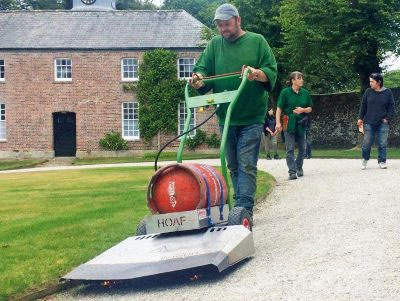
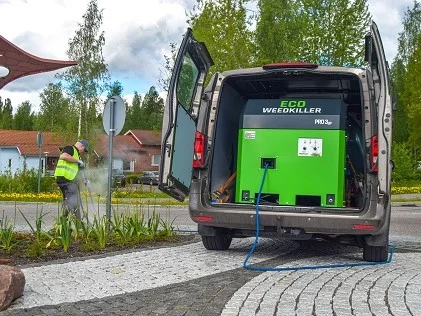
.jpg)
